Learn about the Best Citrus Trees for Containers, as Growing Citrus in Pots is not difficult due to their manageable height and low maintenance!
Citrus trees are, without a doubt, container gardeners’ favorite fruit trees. Oranges, lemons, tangerines: there are so many to choose from. Not just for the fruits, they usually make excellent container plants due to their lush foliage and scented flowers—enough reasons to grow them on your balcony or patio. Let’s have a look at the Best Citrus Trees for Containers.
Best Citrus Trees for Containers
Like all trees you plan to grow in a pot, always select either a natural dwarf or a tree growing on dwarf rootstock. These citrus trees won’t grow tall and produce enough fruits in optimum conditions.
1. Kumquats
Kumquats produce fruit that looks similar to oranges but much smaller in round or oval shape. One more different aspect of kumquats is you don’t need to peel off their skin to eat them. The skin is sweet, and the pulp is tart.
No need to select a variety growing on dwarf rootstock because these citrus trees are naturally short. Kumquats do best in areas with warm summers and chilly fall/winter nights. They’re hardy down to 10 F (-12 C) for some time, especially the round kumquats. In a really cool climate, bring this fruit tree indoors in winter.
- ‘Fukushu’ produces sweeter-than-normal fruit, and the tree is thornless
- ‘Meiwa’ is the sweetest and least-seedy variety of kumquat. Trees are nearly thornless.
- ‘Tavares Limequat’ is a cross between a kumquat and Mexican lime. The tree is attractive and compact (less than 6 feet tall at maturity)
2. Lemons
Lemons are a great choice for areas with both hot and mild summers. They especially enjoy a warm subtropical climate and coastal areas and will produce fruit year-round. It is one of the Best Citrus Trees for Containers!
- Lemon trees are usually short. Grow any variety you want if you live in a climate with mild winters.
- ‘Improved Meyer’ is the best variety for container gardeners living in temperate zones. It is a disease-free version of regular ‘Meyer’ lemons. The fruit is sweeter with thinner skin, thanks to the fact that it is actually a lemon-orange hybrid. It can be brought indoors during the winter without sacrificing fruit production.
- ‘Sungold’ and ‘Variegated Pink’ both have green and yellow variegated leaves.
- Must check out our guide on growing lemon trees to learn more.
3. Mandarins
Not all mandarins are clementines or tangerines, but both of these are a type of mandarin oranges. The fruits are smaller than common oranges, usually seedless or with fewer seeds, sweet in flavor, and easy to peel. Due to their short 10-12 feet, you can easily maintain them in containers.
- Mandarins grow well in full sun and warmth. If growing in a cool climate, save them from cold drafts and low winter temperatures.
- Clementine oranges are a hybrid of mandarins. Sweeter in taste with no seeds and very juicy. Learn how to grow them here.
- Similarly, tangerines are mandarin hybrids as well. They are sweet in taste but more tart than clementines.
4. Oranges
Oranges need hot summers to produce their sweet but little tart fruit. They don’t do well in coastal areas or northern climates with very mild summers.
- ‘Washington’ and ‘Robertson’ are nearly identical varieties of navel oranges. ‘Robertson’ produces fruit two weeks earlier than ‘Washington.’ Growing one of each prolongs your orange harvest.
- ‘Tarocco’ is a blood orange that has red flesh and a complex flavor with raspberry overtones. Makes an excellent espalier.
- ‘Trovita’ has thinner skin than navel oranges and has no navel. It also requires less heat than other types of oranges.
Tip: Choose orange varieties according to your climate and growing conditions.
5. Sweet Limes
Sweet lime is a popular citrus variety in the Asia Pacific, Indian subcontinent, and the Middle East. Its juicy, sweet, and non-acidic fruits are very fragrant and popularly used to make fresh juices. This short tree can be grown on the ground in USDA Zones 9-11 or any other frost-free region.
- Also known as Indian sweet lime, Palestine sweet lime, or Mausambi, it usually doesn’t grow tall; a perfect citrus tree for container growing as it’ll not grow taller than 6-7 feet.
- Like most citruses, it’s a self-pollinating tree.
- It prefers a warm climate and sunny exposure. Growing it is similar to orange trees.
6. Dwarf Bearss Seedless Lime
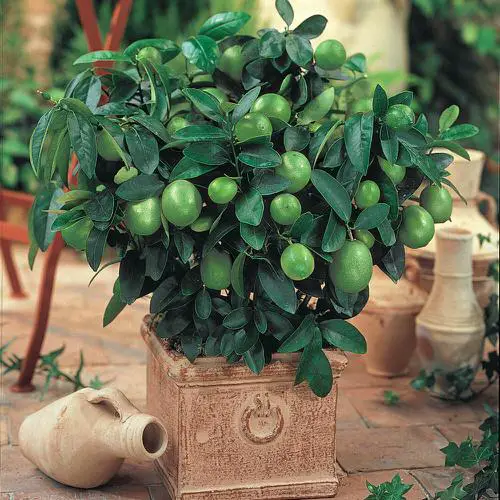
Another one of the best citrus fruits to grow in containers is the Dwarf Bearss Seedless Lime. The fruits are larger and also ripen during winters until early spring.
- It is known to make for a great patio and container plant and looks stunning with its attractive dark-green-colored foliage.
- The fruit is both useful for beverages and cooking purposes.
- It is most popular because it is seedless with a sweet flavor.
- This tree thrives well in USDA Zones 9-11.
- It grows up to a height of 3-6 feet in pots.
7. Kaffir
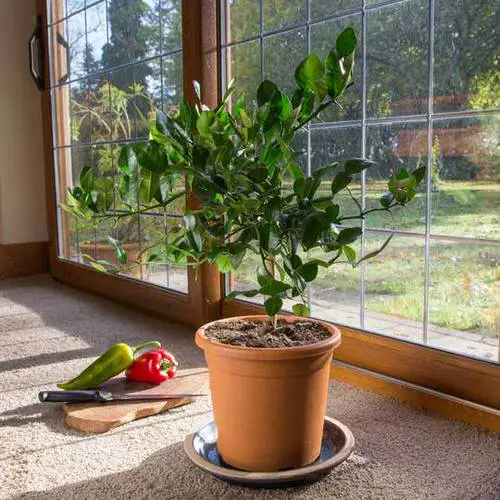
Kieffer Lime, Kaffir, or Makrut Lime are famous for their juices and the tanginess and utilization in Indonesian, Thai, and Cambodian cuisines. The plant grows up to 2-5 feet tall in pots.
- The fruit is dark-green colored and has a bumpy texture and is usually available in the size of a western lime, and has a strong fragrance.
- It is perfect for home chefs and urban gardeners as they can grow this citrus plant in containers.
- This plant thrives well all year round in USDA Zones 9-10.
8. Australian Finger Lime
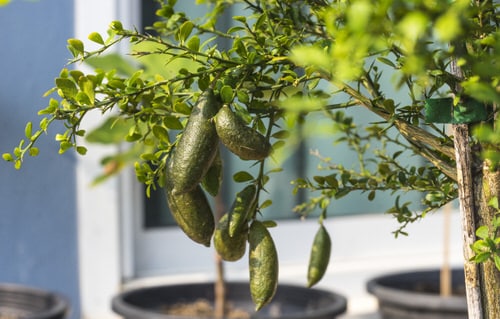
The Australian Finger Lime is also a relative of the citrus family, and it is most popular for producing such an unusual-looking fruit. It can grow up to 20 feet in the wild but reaches about 4-7 feet tall in pots.
- The lime is oblong and long and resembles a finger and thus gets the name.
- It makes for excellent citrus drinks, sauces, marmalades, sauces, and chutneys.
- This unique plant is resistant to deer and birds and can thrive in harsher climates.
- The finger-shaped lime trees can thrive best in USDA Zones 8 to 11 outdoors and indoors in pots in Zones 4 to 11.
9. Wekiwa Tangelo
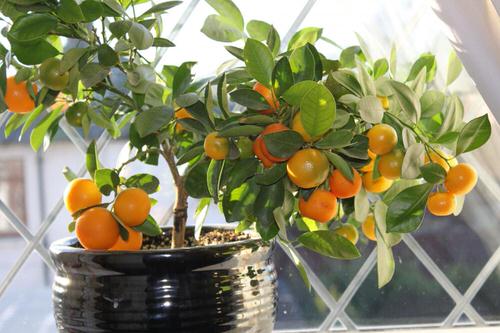
Though this one shares its name with the Minneola Tangelo, this one resembles a pink grapefruit. It can grow up to 3-6 feet tall. It is one of the Best Citrus Trees for Containers!
- The taste reminds one of the tangerine flavors with a subtle hint of a grapefruit.
- The juice of Wikiwa is very sweet and popular, and this hybrid grows well in containers.
- The citrus tree grows best in USDA Zones 8-10.
10. Yuzu
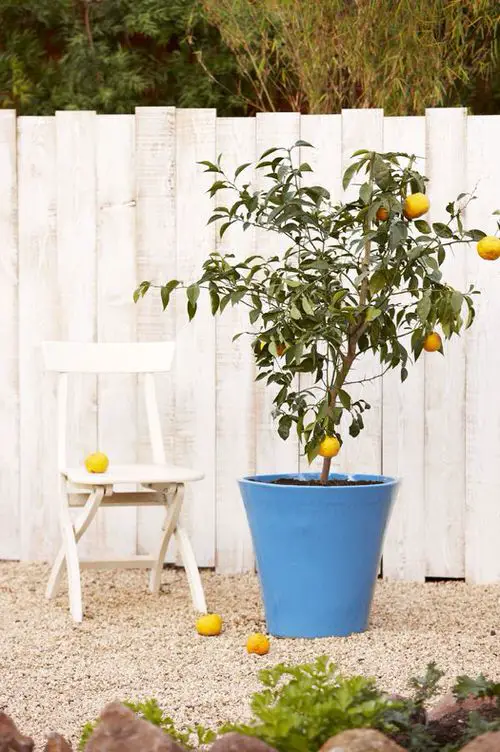
The Yuzu is also called the Japanese Citron and is most loved for its tartness and fragrance that is also capable of retaining the flavor while being cooked. It can grow up to 4-6 feet in pots.
- The fruit is found in dark yellow color and has a lumpy texture.
- This thorny plant is exceptionally cold-hardy and could survive in as low temperatures as 5-10°F or -15-12°C.
- This long-thorned tree is hardy to USDA Zone 8.
How Many Citrus Trees You Should Plant Together for Fruits?
Most fruit trees produce the best harvest when they have a similar type of tree nearby to cross-pollinate. However, most citrus varieties are self-fertile, and you don’t need to grow multiple of these trees together. Good news for small-space gardeners because it means you don’t need to waste space with a second tree.
Growing Citrus in Containers
Choosing the Right Pot
Citrus trees need a pot that is at least 18 inches tall and wide. Select a pot with thick walls; glazed ceramic is ideal. Citrus do not like the super-heated soil found in metal pots.
Tip: Choose the pot according to the size of the rootball of your plant. One or two sizes bigger pot than the size of the rootball is ideal. Shift it to a bigger pot once your citrus plant outgrows the container.
Repotting
You’ll need to gently root-prune and re-pot every 3-5 years or so.
Watering
Do regular watering! You should water your tree often enough so that the soil only briefly dries out between watering. This may be every day in the summer. Withholding water for the week or two before you harvest will help sweeten the fruit.
Pruning
You don’t need to prune citrus trees at all. Pruning will not improve your harvest. Lower branches produce the most fruit, so definitely don’t cut those off. Prune lightly for aesthetic reasons and to remove any dead or diseased branches.
Fertilizer and Soil
Nitrogen is your citrus tree’s best friend. Fertilize monthly from February to November (all year in hot climates) with a high-nitrogen liquid fertilizer according to package instructions. In frost-prone climates, start fertilizing later and stop earlier. If the leaves are deep green with burned tips, you’re feeding too much.
Citrus is also susceptible to the soil that is too alkaline, a problem for those of us with hard water. If you see the light green leaves with dark green veins, you most likely need to re-acidify your potting soil with some soil acidifier (sometimes marketed as a hydrangea blueing agent).
Harvesting Citrus Fruits
Allow the fruit to ripen up on the tree as citrus fruits don’t mature much after being picked. To find out if a batch of fruits is ripe, pick one and taste it. You can’t identify the ripeness of citrus fruits by rind color, as most varieties color quite early, sometimes even before they are ripe.




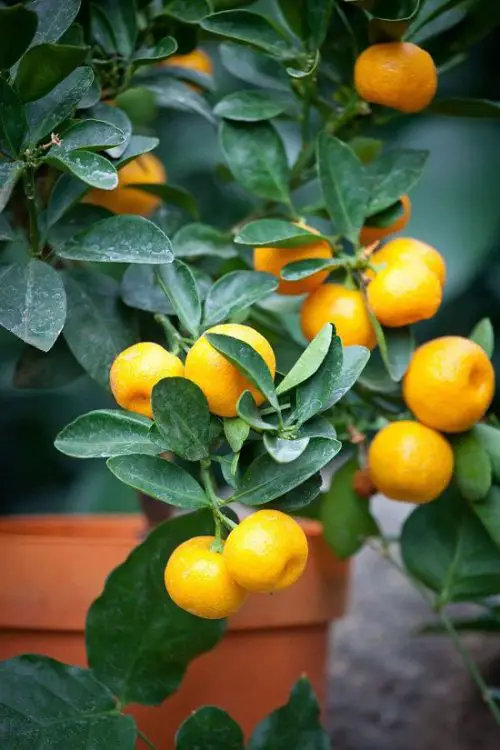

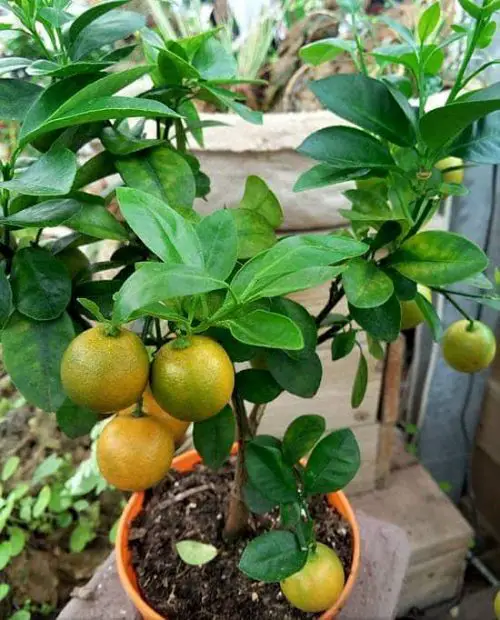
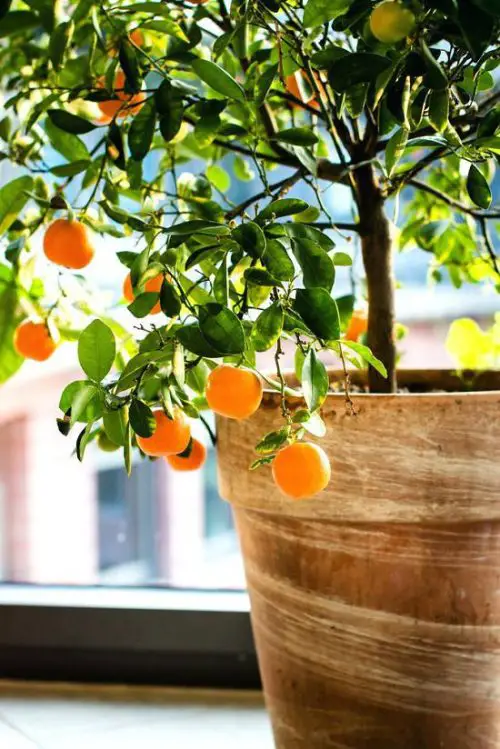

Where can i get seedlings of this dwarf Citrus trees?
Thanks.
If you’re still looking, logees.com has some nice selections. I got a mango from there. It died, but that was my fault, not theirs haha.